Simplified Chinese 中国东北 Wade–Giles Chungkuo Tungpei | Traditional Chinese 中國東北 Hanyu Pinyin IPA [ʈʂʊ́ŋkwǒ tʊ́ŋpèi] | |
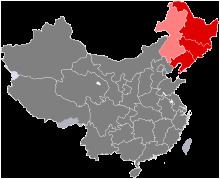 | ||
Northeast china
Northeast China (simplified Chinese: 中国东北; traditional Chinese: 中國東北; pinyin: Zhōngguó Dōngběi) or Dongbei is a geographical region of China. It also historically corresponds with the term Manchuria in the English language. It consists specifically of the three provinces of Liaoning, Jilin and Heilongjiang, collectively referred as the Three Northeastern Provinces (东北三省, Dōngběi sānshěng), but broadly also encompasses the eastern part of Inner Mongolia. The region is separated from Far Eastern Russia to the north largely by the Amur, Argun and Ussuri rivers, from North Korea to the south by the Yalu River and Tumen River, and from the Inner Mongolian Autonomous Region to the west by the Greater Khingan Range. The heartland of the region is the Northeast China Plain. Due to the shrinking of its once-powerful industrial sector and decline of its economic growth, the region is called the Rust Belt in China. As the result, a campaign named Northeast Area Revitalization Plan has been launched by the State Council of the People's Republic of China, in which five prefecture-level cities of eastern Inner Mongolia, namely Xilin Gol, Chifeng, Tongliao, Hinggan and Hulunbuir, are also formally defined as regions of the Northeast. The region is nearly congruent with some definitions of "Manchuria" in historical foreign usage.
Contents
- Northeast china
- Russians flock to northeast china for new year holiday
- History
- Demographics
- Economy
- Culture
- Major universities
- References
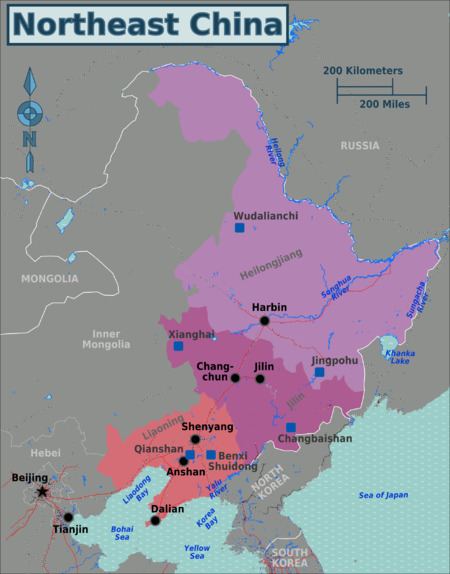
Another term for the area is Guandong (关东 / 關東, Guāndōng), meaning "east of the Pass", referring to the famous Shanhai Pass between Liaoning Province and the neighboring Hebei Province (and also North China) to the west. This name was also used by the occupying Japanese colonists referring to their leased territory of Dalian after the 1895 Treaty of Shimonoseki, as the Kwantung Chou (関東州), which gave name to the occupying Kwantung Army that was later mobilized to set up the puppet state of Manchukuo.

Russians flock to northeast china for new year holiday
History

Northeast China was the homeland of several ethnic groups, including the Manchus (or Jurchens), Ulchs, Hezhen (also known as the Goldi and Nanai). Various ethnic groups and their respective kingdoms, including the Sushen, Xianbei, and Mohe have risen to power in the Northeast. Many Korean kingdoms have also risen to power in Manchuria, including Gojoseon, Buyeo, Goguryeo, and Balhae. Yan State once occupied the Liaodong Peninsula, Han Chinese dynasties in China loosely controlled the southern parts of the region. During the Song dynasty, the Khitan set up the Liao Dynasty in Northeast China. Later, the Jurchen overthrew the Liao and formed the Jin dynasty, which went on to conquer northern China. In AD 1234, the Jin dynasty fell to the Mongols, whose Yuan Dynasty was later replaced by the Ming Dynasty in 1368. In 1644, the Manchu conquered the entirety of China and established the Qing dynasty (1644–1912).

Northeast China came under influence of the Russian Empire with the building of the Chinese Eastern Railway through Harbin to Vladivostok. The Empire of Japan replaced Russian influence in the region as a result of the Russo-Japanese War in 1904–1905, and Japan laid the South Manchurian Railway in 1906 to Port Arthur. During the Warlord Era in China, Zhang Zuolin established himself in Northeast China, but was murdered by the Japanese for being too independent. The last Qing dynasty emperor, Puyi, was then placed on the throne to lead a Japanese puppet state of Manchukuo. After the atomic bombing of Japan in 1945, the Soviet Union invaded the region as part of its declaration of war against Japan. From 1945 to 1948, Northeast China was a base area for the Communist People's Liberation Army in the Chinese Civil War. With the encouragement of the Soviet Union, the area was used as a staging ground during the Civil War for the Chinese Communists, who were victorious in 1949 and have been controlling this region since.
Demographics
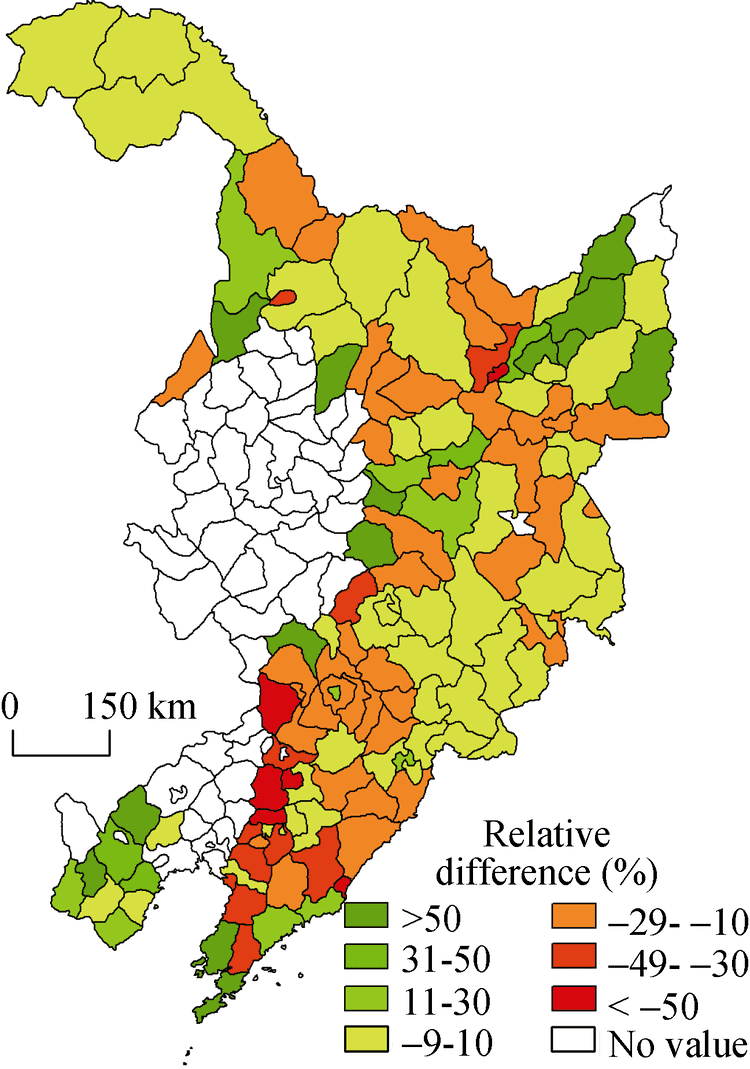
Northeast China has a total population of about 107,400,000 people, accounting for 8% of China’s total population. The overwhelming majority of the population in the Northeast is Han Chinese, many of whose ancestors came in the 19th and 20th centuries during a migration movement called "Chuang Guandong" (闖關東, literally "venture into the east of the Pass"). Northeast China historically had a significant Han Chinese population, reaching over 3 million by the end of Ming Dynasty, but they were subjected to cleansing, eviction and assimilation by the conquest of the Manchu Qing Dynasty , who then set up Willow Palisades during the reign of Shunzhi Emperor and prohibited any settlement of Han Chinese into the region. The Northeast then remained sparsely populated until the ban was finally lifted during the late Qing in response to the Russian incursions into Outer Manchuria (which resulted in the region's annexation by Russia after the Treaty of Aigun), and a large influx of migrant settlers, mainly landless peasants from the nearby Hebei and Shandong provinces, came in a scale equivalent to the 19th century American westward expansion, resulting in the local Han Chinese population to grow over 20 million before the Second Sino-Japanese War. After the establishment of the People's Republic of China at the end of the Chinese Civil War, further immigrations were organized by the Central Government to "develop the Great Northern Wilderness" (开发北大荒), eventually peaking the population over 100 million people.
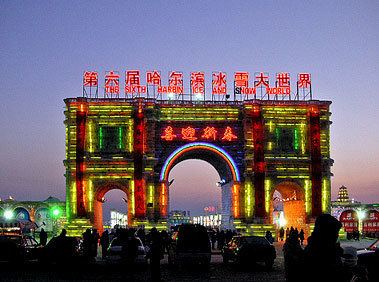
Because most people in Northeast China trace their ancestries back to the migrants from the Chuang Guandong era, Northeastern Chinese were more culturally uniform compared to other geographical regions of China. People from the Northeast would first identify themselves as "Northeasterners" (东北人) before affiliating to individual provinces and cities/towns.
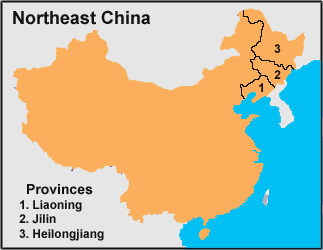
Ethnic Manchus form the second significant ethnic group in Northeast China, followed by the Mongols, Koreans, and the Huis, as well as 49 other ethnic minorities such as Daurs, Sibos, Hezhens, Oroqens, Evenks, Kyrgyzs, etc.
Economy
The Northeast was one of the earliest regions to industrialize in China during the era of Manchukuo. After the founding of the People's Republic of China, Northeast China continued to be a major industrial base of the country. Recent years, however, have seen the stagnation of Northeast China's heavy-industry-based economy, as China's economy continues to liberalize and privatize; the government has initialized the Revitalize the Northeast campaign to counter this problem, and established the Northeast Summit to improve policy coordination and integration.
The region is, on the whole, more heavily urbanised than most parts of China, largely because it was the first part of the country to develop heavy industry owing to its abundant coal reserves. Major cities include Shenyang, Dalian, Harbin, Changchun and Anshan, all with several million inhabitants. Other cities include the steel making centres of Fushun and Anshan in Liaoning, Jilin City in Jilin, and Qiqihar and Mudanjiang in Heilongjiang. Harbin, more than any other city in China, possesses significant Russian influences: there are many Orthodox churches that have fallen out of use since the Cultural Revolution. Shenyang and Dalian, meanwhile, have sizable populations of Japanese and South Koreans due to their traditional linkages.
The rural population of the Northeast is heavily concentrated in the warmer southern part of the area, where very warm to hot summer weather permits crops such as maize and millet to be grown with high yields. Soybeans and flax are also very important, as are wheat and barley. The region possesses large flocks of sheep, and pigs are abundant in the more densely settled southern part. The northern half of Heilongjiang province is so cold and poorly drained that agriculture is almost impossible; however, the Amur River (Hēilóng Jiāng, 黑龙江, "Black Dragon River") provides very rich fishing prospects, and sheep are even more abundant than in southern Heilongjiang province.
Northeast China is the country’s traditional industrial base, focusing mainly on equipment manufacturing. Major industries include the steel, automobile, shipbuilding, aircraft manufacturing, and petroleum refining industries. The gross regional product of the three northeast provinces totaled ¥1.63 trillion in 2002. In recent years, the Chinese government has initialized the "Revitalize the Northeast campaign" to turn this region into one of China's economic growth engines. As of 2015 the region was losing population and the economy, dominated by state-owned enterprises, was stagnant.
Culture
There are two main dialects of Mandarin Chinese spoken in Northeast China. The dialect spoken in the majority of the Northeast is the Northeastern Mandarin, which is a very slight variant of the Standard Chinese but retains sporadic elements from native Tungusic languages, Japanese and Russian, where there are enough differences to give the dialect its own distinctive characteristics. However many residents in the southern fringe of the Liaodong region (mostly in Dalian and Dandong) speak the Jiaoliao Mandarin, which is actually a Shandong dialect. Some Northeasterners often jokingly call the Northeastern dialect as the "corny accent" (Chinese: 大碴子味, referring to inland regions where maize is a staple crop), and the Jiaoliao dialect as the "oystery accent" (Chinese: 海蛎子味, referring to coastal areas like Dalian which are famous for seafoods).
Ethnic Manchus speak mostly Mandarin, and the Manchu language is almost extinct due to widespread assimilation to Han culture over the last four centuries. Mongols tend to be bilingual in their own Mongolian tongues as well as Mandarin.
Northeastern Chinese cuisine reflects the region's ethnic diversity. Native, Manchu, Northern Chinese, Russian, Korean and Japanese cooking styles all find their traces in Manchurian cooking. One of the distinguishing characteristics of the cuisine is the use of uncooked fresh vegetables. During the long winter season, pickled Chinese cabbage, which is called "Suan Cai", is preserved and used for cooking. In almost every other region of China, vegetables are cooked thoroughly before being eaten.
In general, the culture of Northeast China takes its elements from the cultures of North China and Shandong, where most of the Han Chinese migration into Northeast China, known as Chuang Guandong (闯关东), originated, the native Tungusic peoples, and its own innovations.
Errenzhuan, Yangge, Jilin opera and Stilts are popular forms of traditional entertainment in Northeast China. "Northeastern Cradle Song" (东北摇篮曲) is an example of the folk songs of this region.
Because of its climatic conditions, Northeast China is the base for China's winter sports. Ice hockey and ice skating athletes often come from or were educated in Northeast China.
